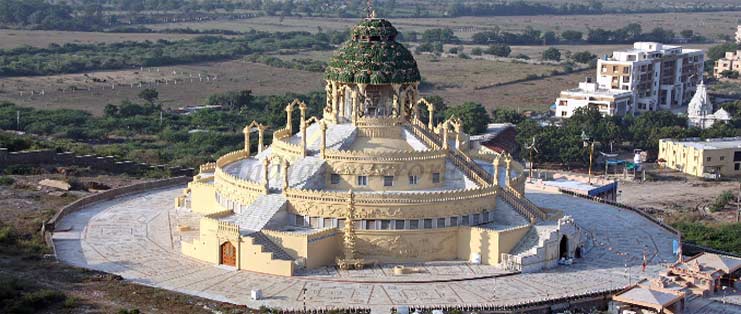All parts of the world have their own customs and we all celebrate in similar and different ways. We are all familiar with our festivals and holidays in the United States, but we are often unfamiliar with the customs and celebrations of many of our foreign neighbors. Many of their holidays contrast greatly from ours. For example, the festival Paryushana, which is held in India each year as a celebration among the Jain population, is considered one of the most sacred days of the year to Jains. The festival started over two thousand years ago when Jainist monks refrained from traveling during the rainy monsoon season, on account of the many kinds of bugs that would naturally come up from the ground. Jainist monks avoid stepping on these bugs as part of their religion, since they believe that it is harmful to their own selves to inflict any harm on any other living things. As part of this festival, there are a variety of activities that take place during this week-long celebration. Paryushana typically last between eight to ten days, and during this week, the main goal is for participants to seek forgiveness for their sins. Paryushana usually takes place in either August or September each year, depending on their lunisolar calendar. The word Paryushana means “to come together,” and when they come together for this festival, Jains dedicate themselves to worshiping and to fasting.1

There are two groups in Jainism: the Svetambara and the Digambara. The two Jain sections only have minor differences in beliefs concerning clothing and women. Digambaras practice nudity as one of the requirements to achieving liberation, whereas Svetambaras don’t believe that nudity is needed for salvation. Digambaras also believe that women lack the body and will to reach liberation, so they need to be reincarnated as a man before they would be able to attain such a goal. But Svetambaras say that women are able to get to the same spiritual liberation as men. The way that they both celebrate Paryushana is by fasting and participating in several spiritually enlightening sessions of meditation. One difference during this festival is that Svetambaras read from the Kalpa Sutra, a Jain text, and Digambaras read from the ten chapters of the Tattvartha Sutra.
Since Jain monks avoid walking from one town to the next, they stay in temporary locations during this week of Paryushana. Most commonly a town will invite Jain monks into their homes and let them stay for the duration of the festival, welcoming them with a ritual, one of which is presenting the monk with a milk bath, which is a purity ritual that cleanses the monk of germs and keeps his body healthy. Paryushana is a period of remorse for the sins Jains have done in the previous year, and they pray and ask for forgiveness to remove the gained karma (Jains define karma as actions that predict their next life). This karma differs from Hindu karma due to how extensive Jain karma applies to their life. Instead of just good or bad actions contributing to karma as is case in Hinduism, Jains believe that thoughts and words also apply to gaining positive or negative karma. They also vow to control their desires for material pleasures as part of the festival. To do this, they disown any possessions and avoid eating anything. This spiritual fasting lasts for the whole festival, but some simply cannot fast the entire time. It is mandatory, however, to fast on the last day. On the third day of this celebration, the sutra books are displayed in homes of Jains, where these texts are worshiped with religious songs. On the fifth day of Paryushana, ceremonies are held in monastic temples where Jains meditate and read from the Kalpa Sutra and Tattvartha Sutra. During this special ceremony, the group listens to stories about the mother of Mahavira, the founder of the faith. The purpose of the stories is to remind those gathered about the core teachings of Mahavira, about the importance of positive thought, that living beings should not be harmed, that there is a brotherhood among fellow Jains, and that forgiveness should be shown to all living beings. There is also an invitation to visit all neighboring Jain temples. The last day of Paryushana is the most important. On this day Jains participate in fasting, and the ones who fast extensively are honored because of their good example for other followers. This day is also when Jains ask for forgiveness from friends and family for any wrongs they have done in the past year toward them. On the final night of the festival, it is the custom to have a Swami Vastyalaya dinner, where all Jains, no matter their social caste, are welcomed and they all sit together to eat and drink. It is a time to explore the inner self and become a better person.2

Jainism is one of the oldest religions of India, dating back to the sixth century BCE. Today, Jains account for 0.4% of the population of India. The founder of Jainism is Vardhamana Mahavira, whose life spanned from 540 to 468 BCE. Mahavira is thought to be the twenty-fourth Tirthankara, or spiritual teacher of the righteous path to liberation. He belonged to the warrior caste, but abandoned his family and possessions out of fear for a painful death. He went to purify himself to attain a state of bliss. In his forty-second year, he began preaching his religion all over the country for thirty-two years. Mahavira claimed to have gained full enlightenment, and thereby became a Jaina, or conqueror, and became the leader of those who sought Jaina, or Jainism. The present form of Jainism was shaped by him. Originating on the Indian subcontinent, Jainism is one of its oldest religions. Its followers claim that Jainism is actually much older than Mahavira, that it has prehistoric origins dating to before 3000 BCE, before the beginning of Indo-Aryan culture.3
Jains have very strong and specific practices and values. Jains are probably the most nonviolent group of people in the world. They attempt to never harm humans or animals, or any life forms, and they regularly undergo long fasts, participate in meditation, pull their hair out by the roots two to five times a year, walk barefoot, and in some cases, for monks, do not wear clothes at all. Jains have doctrines that contain beliefs about the nature of the world, beliefs about what one should and shouldn’t do, and what one should value. The five doctrines for its followers are Ahimsa (non violence), Satya (truth), Asteya (no stealing), Brahmacharya (self restraint of marriage and sexual relations for holy people), and Aparigraha (non possessiveness). In the Jain tradition, qualities that are important are the giving of education, shelter, and food, and the curing of illnesses, and encouraging the protection of all humanity. Those who practice these values are thought to reap the benefits of wealth, power, and good fortune, and to have virtuous sons and daughters, as well as being reborn as a god. Jainism emphasizes that the suffering of rebirth can be brought to an end, and that achieving moksha, or the liberation from that cycle of rebirth, is the best reason to practice Jainism.4

Fasting is very common in Jainism, and is one of the key elements in the festival of Paryushana. It is more often done by Jain women than men. The reason Jains fast is to purify the mind and body, as it reminds one of Mahavira’s emphasis on renunciation and asceticism. During the fast, the Jain must not just stop eating but also stop wanting to eat; therefore, they can’t desire food or else the fast is pointless. There are four different types of fasting practiced by Jains: complete fasting (giving up food and water completely for a period), partial fasting (eating less than you need to avoid hunger), vruti sankshepa (limiting the number of items of food eaten), and rasa parityaga (giving up favorite foods). Some Jain monks fast for months, following the example of Mahavira, who fasted for over six months. Others have fasted for a year, like Sri Sahaj Muni Maharaj, who completed his record-breaking 365-day fast on May 1, 1998. These people are usually praised during the festival of Paryushana, because they have set an excellent example for other followers. The last type of fast is Santhara, or fasting to death. It is a procedure where a Jain prepares for death when the body is no longer capable of serving itself and when death is a matter of undisputed certainty, most often related to old age. Before the body dies, the intention is to purify the body, remove thoughts of personal things, and lift ones karma. Those practicing Santhara avoid desires and dislikes, so they can concentrate on the spirit while they approach death. Santhara has been seen as the ultimate way to remove all sins and karma, liberating the soul from the cycle of rebirth.5

Meditation also takes place on the week of Paryushana. The purpose of practicing meditation is to purify the mind, speech, and body. During this week-long festival, Jains try to stabilize the mind and concentrate on achieving salvation. There are four kinds of meditation: sorrowful meditation (related to suffering of impatience, grief, and agony of disease), inclement meditation (related to harsh thoughts, lacking mercy), righteous meditation (beneficial to help self and others), and spiritual meditation (focus on mind). All of these meditations help destroy karma from the soul.6 For Jains, the soul has three parts: the atma dravya (soul as one unit of infinite soul substances), ananth gunnas (its infinite qualities), and ananth paryaas (the modifications/expressions). Jains interpret the soul as not a man, woman, rich, poor, ugly, worker, husband, wife, son, daughter, or heavenly/hellish being, but as only an unchanging spirit. Jains consider the soul as something that can take place in any form in life, and so all should be treated equally, which ties back to a meditation service during Paryushana that encourages all followers, no matter what social caste, to participate.7
Directing our focus to other customs in the world opens our minds to being able to see their perspectives. We all may have similar morals, but holidays such as Paryushana brings a whole new meaning to the linking of religions. We may not fast, but we commonly ask for forgiveness in prayer to our god or gods, and hold special days for our holy figures. The goal within Christianity, for example, may be to enter the pearly gates of heaven; the holy week of Paryushana unifies Jains as a group to reach one goal: liberation. The Jainism that started many millennia ago is still practiced today. The forms of fasting and meditation are valued so highly that many go to extreme measures in these conditions. For Jains, karma influences a Jain’s life greatly by guiding what they do everyday, not just in actions but in feelings and thoughts as well. It may be difficult to see how this religion works, especially compared to Western beliefs, but in a Jain’s eyes, fasting and forgiveness is absolutely pure and necessary to attain freedom from the cycle of rebirth into the transcendent state.
- Michael McDowell, World Religions At Your Fingertips (New York: Penguin, 2009), 225-226. ↵
- David DeRocco, The International Holiday & Festival Primer (Canada: Penguin, 1996), 15.1-15.2. ↵
- Ottilingam Somasundaram, “Jainism: Tamil History,” Indian Journal of Psychiatry 58, no. 4 (Oct-Dec 2016): 471-474. ↵
- Sherry Fohr, Jainism (London: Bloomsbury Academic, 2015), 1-3. ↵
- “Religions – Jainism: Fasting.” BBC. September 10, 2009. Accessed October 09, 2017. http://www.bbc.co.uk/religion/religions/jainism/customs/fasting_1.shtml. ↵
- Dr. Rajendra Kumar, “Meditation in Jain Scriptures,” Jainism Literature Center – Articles. Accessed October 11, 2017. https://sites.fas.harvard.edu/~pluralsm/affiliates/jainism/article/meditation2.htm. ↵
- Encyclopedia of Jainism, December 2013, s.v. “Meditation-Dhyan in Jainism,” by Smt. Arpita. ↵



41 comments
Gabriella Parra
I’ve always been interested in Jainism because of how the religion has been kept alive for so long. It barley gets touched on in schools, so it was great to learn about a specific tradition of Jainism rather than just scratch the surface of the religion. It has to take a lot of discipline to hold to Jainism which makes me interested to learn about people’s experiences growing up practicing it.
Madeline Emke
This article depicts a specific holiday within the Jain religion: Paryushana. Throughout this holiday, Jainists focus on the forgiveness of their sins through meditation and fasting. I am deeply impressed by the dedication it could take to fast for a week straight, as well as thinking, saying, and acting in the right ways. One strange thing I noticed was that thinking of food ruined the entire fast because it meant that the person was not thinking in the right way. For me, this would be impossible because, even during lent or small days of fasting, I constantly think about food.
Vania Gonzalez
Interesting article I had not known a lot of this information on Jainism other than it was a religion that practiced meditation and fasting. Other religions are always so interesting to me because each one is unique. The way this tradition of their festival started is interesting because long lasting memories and traditions always start when you do not expect or are trying to make them happen.
Engelbert Madrid
It’s interesting to learn about different cultures and religions from different countries that have a unique doctrine of sanctity and purification. I’ve heard of Jainism before, but I didn’t know anything about this religion. After reading this article, I can tell that Jainism seeks to find purity in one’s self. Furthermore, it is one of the religions that does demonstrate peace unlike Christianity, Islam, and Judaism that have fought bloody wars for the sake of their god.
Christopher Vasquez
It’s interesting learning about the different cultures and practices around the world. What I find most interesting is that there are many similarities between cultures; for example, in the festival of Paryushana, one of the main components is the cleansing of one’s sins. In Catholicism, absolving (or cleansing) of one’s sins is central to the faith. I also thought the differences between the Svetambara and the Digambara are interesting. All in all, this was a great, informative article. Thank you!
Harashang Gajjar
Jains often take time off from work during this period and eat a much simpler diet. They add to their normal vegetarian restrictions by avoiding such foods as potatoes, onions, and garlic the eating of which entail killing the plant instead of just taking its fruit. Many Jains also fast during Paryushan, some for the entire period. At the end of Paryushan, those who have fasted for the eight or ten days break their fast with a special meal during which they do not touch food, but are fed by friends and loved ones in honor of their achievement.
Steven Hale
I cannot imagine the mental and emotional discipline required to practice Jainism. For many of us in America, religion is a weekly (or less frequent) event, but the fasting and emphasis on saying and even thinking the right things at all times has to be so difficult. I find it really admirable that people commit to that consistent and devoted of a lifestyle.
Andrew Dominguez
Before this article, i wasn’t aware of the practices in which the Jains will do. What i found shocking is how if they think of food while fasting, than the whole fast is ruined. Another thing i thought was strange was they would starve themselves to death, thinking it would cleanse them. What i found interesting is there was two different types of Jains, one which girls could reach Nirvana, and one were they couldn’t.
Robert Rodriguez
Great article! Ive always been very fond of religions and cultures that are pacifist, although these ideas would make the world better Jainism is more to the extreme. The article was very well written, I wasn’t aware of the things that Jainist celebrate. I loved how the religion was explained, I didn’t know that Jainist fasted so often… makes me think that one that follows the religion must be very dedicated to it.
Maricela Guerra
Jainism is so fascinating, living in a world where there is no violence everything should be protected and sacred. Especially when it is taken place in India, where even the animals are sacred. I find it interesting when if you are not a person in this life, then in the next bad things will happen. It helps those to become good people after hearing this reincarnation.